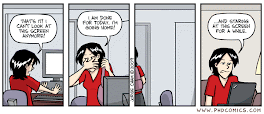Solutions
Low or even medium hyperopias are difficult to diagnose because, as I wrote in one previous post, they “consume” the refraction. Besides, they are difficult to be detected by parents or teachers because these hyperopic people have a more or less clear vision in any distance. That is why these people need a COMPREHENSIVE EYE EXAM from early age and a chekup once a year.
In that comprehensive visual examination the refraction that the visual system of the hyperopic person is constantly compensating is checked, along with other skills of the visual system, specifically her accommodation which is the one that is working all time, and if it (accommodation) may have disturbed other visual skills.
In the case that the refraction error can be diagnosed or that the error is causing a certain symptomatology, these are the possible solutions:
- Eyeglasses, either if she needs them to see clear because she has a high hyperopia, or if she has a low one and needs them to avoid that constant effort for close-up tasks, and this way, avoiding certain symptomatology. In the last case, eyeglasses are not used for seeing clear.
In the case of a high hyperopia, the use of eyeglasses can make sense both for short and long distance seeing, if the visual acuity for long distance is reduced.
In the case of lower hyperopia, that is causing some symptoms, the option of eyeglasses is good because she does not require wearing them during all day.
Hyperopia is corrected with plus, positive or convex spherical lenses (thicker at the middle than in the edges of the lens), that optically falls in front the image, on the retina.

- If hyperopia is higher than +1.50 diopter, another option for compensating it, is by wearing contact lenses for a long period of time. In this case, unlike myopia, each patient may use the best contact lens for her, that is, there is no suitable specific one. There is no one that stops the hyperopia, simply because as I have explained, the hyperopia does not increase.
There exists a research about Orthokeratology, carried out specifically in Australia, which tries to find a contact lens that model the cornea and reduce the hyperopia; but even, as I say, it is under research.
Hyperopic people are usually more uncomfortable wearing contact lenses than eyeglasses, because although her visual field is bigger wearing contacts, the size of images is more real; but wearing eyeglasses with plus lenses, they magnify the objects (I will explain this effect later); therefore, as they see everything bigger wearing the glasses, they are more comfortable wearing them than with contact lenses. - Vision Therapy is the best allied in this refraction disorder. A hyperopic person does not often respond to lens correction alone, but they are required to “remediate” accommodative dysfunction. With therapy we teach her to control her accommodation and her convergence and to perform her close-up tasks without effort. We will avoid that this to happen again.
Within vision therapy, besides some simple visual activities, the use of eyeglasses with a low positive refraction will be able to relieve her symptomatology in order to be able to perform the daily close-up tasks. This way, she relieves all accommodative effort that she constantly performs. - Besides, as it happens with myopic people, some simple VISUAL HYGIENE AND ERGONOMIC RULES will help prevent her reaching that visual stress. Modification of the patient's habits and visual environment is occasionally useful as an adjunct therapy.
Mainly:- Improving lighting or glare reduction
- Using better quality printed material.
- Decreasing temporal demands, with frequent rests.
- Looking far away and focusing on something, frequently, when performing close-up tasks.
- Etc.
- Improving lighting or glare reduction
- Lastly, surgery: hyperopia is a refractive defect that can be operated as well, but except for high hyperopias, it is not considered as the best option.

RELATED POST
Refractive disorders: Hyperopia , Hypermetropia or Farsightedness. (1) Vision and Accommodation
Refractive disorders: Hyperopia (2) Different features.
Refractive disorders: Hyperopia. (3) Symptoms.
Refractive visual disorders. Some clarifications.
Some numbers...






No comments:
Post a Comment